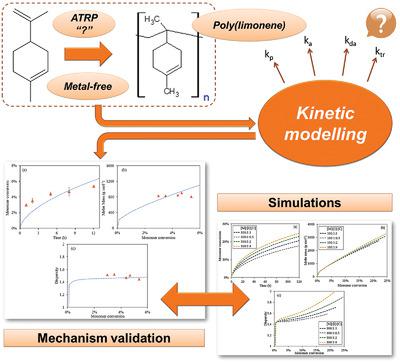当前位置:
X-MOL 学术
›
Macromol. Chem. Phys.
›
论文详情
Our official English website, www.x-mol.net, welcomes your
feedback! (Note: you will need to create a separate account there.)
An Experimental and Computational Approach on Controlled Radical Photopolymerization of Limonene
Macromolecular Chemistry and Physics ( IF 2.5 ) Pub Date : 2020-10-13 , DOI: 10.1002/macp.202000199 Ramon Victor de Castro Alvarelli da Silva 1 , Roniérik Pioli Vieira 1
Macromolecular Chemistry and Physics ( IF 2.5 ) Pub Date : 2020-10-13 , DOI: 10.1002/macp.202000199 Ramon Victor de Castro Alvarelli da Silva 1 , Roniérik Pioli Vieira 1
Affiliation

|
Limonene is a potential candidate for the synthesis of polymers from renewable and non‐toxic sources. The synthesis of poly(limonene) via controlled photopolymerization is studied for the first time, both at an experimental and computational level. A kinetic modeling is developed and all unknown parameters are estimated by adjusting them to the experimental data (conversion, molar mass, and dispersity). The reasonable model fit indicates that the proposed mechanism can be considered valid for this process simulation. In that fashion, different reagent ratios are evaluated, as well as simulations for long polymerization times. The experiments provide less than 10% monomer conversion at 40 °C, and short times. However, it is possible to identify a reasonable polymerization control (dispersities <1.5). In a complementary way, the simulations allowed to identify a threshold of reagent ratios in order to maintain the polymerization control for conversions around 20%, and at the same time enable monomer conversions at the same level as traditional thermally‐initiated radical polymerizations at high temperatures. Therefore, this new route can be a promising alternative for the synthesis of limonene‐based polymers.
中文翻译:

柠檬烯受控自由基光聚合的实验和计算方法
柠檬烯是从可再生和无毒来源合成聚合物的潜在候选者。首次在实验和计算水平上研究了通过受控的光聚合合成聚柠檬烯。建立了动力学模型,并通过将其调整为实验数据(转化率,摩尔质量和分散度)来估计所有未知参数。合理的模型拟合表明,对于该过程仿真,所提出的机制可以被认为是有效的。以这种方式,可以评估不同的试剂比例,以及进行长聚合时间的模拟。实验在40°C且短时间内提供了不到10%的单体转化率。但是,有可能确定合理的聚合控制(分散度<1.5)。作为补充,模拟可以确定试剂比率的阈值,以将转化率的聚合控制保持在20%左右,同时使单体转化率与高温下传统的热引发自由基聚合反应的水平相同。因此,这种新方法可能是合成柠檬烯基聚合物的有前途的替代方法。
更新日期:2020-11-19
中文翻译:

柠檬烯受控自由基光聚合的实验和计算方法
柠檬烯是从可再生和无毒来源合成聚合物的潜在候选者。首次在实验和计算水平上研究了通过受控的光聚合合成聚柠檬烯。建立了动力学模型,并通过将其调整为实验数据(转化率,摩尔质量和分散度)来估计所有未知参数。合理的模型拟合表明,对于该过程仿真,所提出的机制可以被认为是有效的。以这种方式,可以评估不同的试剂比例,以及进行长聚合时间的模拟。实验在40°C且短时间内提供了不到10%的单体转化率。但是,有可能确定合理的聚合控制(分散度<1.5)。作为补充,模拟可以确定试剂比率的阈值,以将转化率的聚合控制保持在20%左右,同时使单体转化率与高温下传统的热引发自由基聚合反应的水平相同。因此,这种新方法可能是合成柠檬烯基聚合物的有前途的替代方法。











































 京公网安备 11010802027423号
京公网安备 11010802027423号